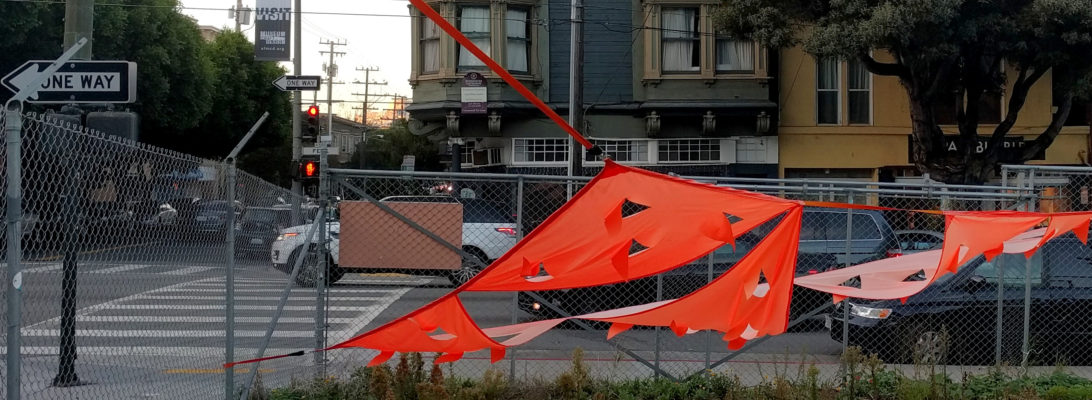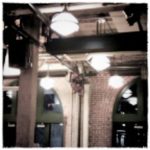Final post about Transportation Camp (hosted by OpenPlans @SF Public Works this past weekend) to wrap up my notes. In addition to the previous post on Sexy Transit, I also attended three other sessions on Saturday.
Session #1
The first session I attended was also my first unconference presentation. I wasn’t really sure what to do or who would show up, but a group of very experienced people showed up to discuss “Livable Streets and Public-Private Partnership” with me. I wasn’t sure how the session would go, but thanks to everyone’s ideas it went pretty well. We started off brainstorming some ideas about what a livable street entailed. Some of the key things that make a street “livable” according to the session’s participants included:
- Equal access for transit, bikes, peds, cars
- Mixed use development (residential, commercial, eateries, outdoor space)
- A place I like to spend time
- Green space (parks, gardens, recreation, landscaping)
- Safe for pedestrians and bicycles
- Traffic calming
The we discussed the public sector’s role in creating a livable street – what were some of the main obstacles, and some areas that could be productive:
- Policy takes too long to change – current detrimental policies could have been invented decades ago and affect us today
- Some environmentally focused policies can have a negative affect on creating better cities. One example was CEQA, and could also include zoning and road capacity issues that act as a deterrent to smart development.
Private sector challenges and roles were also a topic:
- Branding and corporate sponsorship are one way to pay for public spaces, but there could definitely be some blowback from this depending on how blatant is was and access issues
- Merchants may be wary to lose parking spaces
 London’s Blue Bike lanes – from Alttransport
London’s Blue Bike lanes – from Alttransport
Finally, we tried to parse out a couple different areas where public-private partnership could be most productive in creating healthy, livable streetscapes where people like to spend time and money:
- “Adopt a highway” is a very visible program. However, similar projects on behalf of BIDs and “Adopt a Street” programs are generally focused on cleaning up litter, etc. Can these be expanded to include landscaping, partnership with businesses to create parklets, working with the city?
- Nonprofits have an important role to serve as arbiter between cities and businesses to create livable streets. They can serve to educate, do outreach and marketing trials, and explain the benefits to merchants.
- What is an acceptable level of corporate sponsorship? One example was “bank sponsored” blue bike lanes in the UK. Others include “private outdoor space” for eating lunch in atriums and plazas downtown.
- Parklets are a good way to promote the idea of livable streets when a merchant, with the help of the city, requests one. Can make the business more accessible and attractive to pedestrians and cyclists and can encourage people to linger. Two parking spots don’t generate much business, but those two spots can be turned into a space for eight people to eat, park their bicycles or sit next to a planter. Streetsblog has a list of ways for you to request a parklet here.

Here’s a photo of the Mojo parklet in my ‘hood from socketsite.com I was surprised to see one of the first commenters denigrating this “down and out neighborhood” and expressing the view that the improvements are worthless. Pretty pathetic! I’d like know what this person thinks of some real “down and out neighborhoods” in other cities, because this does not qualify! I suppose we should never make small improvements to our neighborhoods either since, you know, it’s all or nothing. Ugh – this is a whole ‘nother post.
I enjoyed leading the session and hearing everyone’s ideas! I’d love to get a copy of the notes when and if they go up online.
Session #2
This one was on “Employers and Transit”. I was a little of my knowledge zone in this group, with a lot of experts on employer commuting benefits and vanpools. Never having worked at a location with more than a dozen employees, the idea of a vanpool is pretty vague for me. Still, I took away some useful ideas and knowledge from this session!
- Company culture is important when looking at commuting and transit. Does the company culture look kindly on employees using alternative transit? Can you leave early from a meeting to get your vanpool?
- Transit benefits for cyclists are “transient” in nature – some have them, some don’t, no one can figure out how much they’re worth. In addition, many companies don’t have adequate services for cycle (or running!) commuter who need to change, safely store their gear, etc. It seems the only “benefit” cyclists really get so far is that they probably won’t need to pay for a gym membership after cycling off all those miles that they could be getting reimbursed to the tune of $200/month for if they chose to take the bus!
- Land use is a surprisingly important aspect when looking at large companies and transit issues: think about how many more commuters or “single occupancy vehicles” a new Twitter or Salesforce location in downtown SF could create! Similarly, some attendees noted that large corporations in the Bay are truly “externalizing” the cost of their cheap corporate campuses (compared to downtown SF or Berkeley) in Silicon Valley onto the public transit and highway systems and onto their employee’s time and money!
- While vanpools help keep single occupancy vehicles off the road and are an employee benefit, they are not open to the public and do not contribute to a potential groundswell of merchants and employers demanding better transit service.
Session #3
This session was on “Ensuring Equal Access.” I forgot the name of the lovely gentleman leading the session in my photo, below. Does anyone know who it was? Please tag or add his name.
This was an enjoyable discussion (if at times a little out of my depth). Topics included how public data can be better translated for the public by developers (rather than public agencies), how deferred infrastructure creates challenges, and also touched upon public-private partnership again.
- What happens when governments give away their transit data and it is all used for new applications that aren’t accessible to many users (or only to those with the tech knowledge and devices to harness it)
- Could a public-private partnership create better bus stops – “sponsor a bus stop” with better realtime bus info, shelter, and design?
- Favorite quote of session: “tourists and other new users of transit systems have ‘low vending machine literacy’

All in all, very thought provoking and useful meeting. I like the unconference format a lot (I knew I would) and hope to see it and use it again. It was neat to meet such a wide cross-section of people and experiences within one overarching field. It was inspiring to use my brain to engage with others and create dialogue on issues I care about – especially after this long stint of unproductive and depressing unemployment. If you’re reading this, yes, I’m still looking for my next job. Are you hiring?



 London’s Blue Bike lanes –
London’s Blue Bike lanes –





